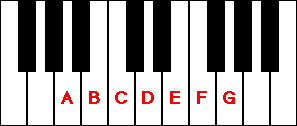Piano

One advantage of the piano is that the player doesn't need to concern himself with intonation; that is, whether the note being produced by the instrument is in tune or "on pitch", as with the voice. If you press the "A" key, it will produce an "A", simple as that. (Provided that you have your piano tuned regularly!)
So the first thing to do on the piano is to learn to recognize the note names in relation to the keys on the keyboard. You've already seen an example of this earlier in the course, but this illustration will serve as a reminder:

Notice that the black keys occur in groups of two and three. An easy reference point is to remember that the white note in between the group of two black notes is D. Everywhere on the piano keyboard that you see a group of two black notes, the white note in the middle is D. You can figure out the other note names by counting up or down from there.
As with pitch recognition, the fastest way to learn to recognize the note names on the keyboard is to use the flashcard approach.
With the piano, as with a variety of other instruments, multiple notes may be played at the same time. This is indicated on the staff by lining the notes up vertically, or stacking them one on top of another. For example:

Notes that occur on the bass staff are usually played with the left hand, while notes that occur on the treble staff are usually played with the right hand.
It may seem challenging to have each of your fingers working independently to produce a song, but there are many excellent books that use a step-by-step approach to help a beginner develop this kind of agility and coordination.
